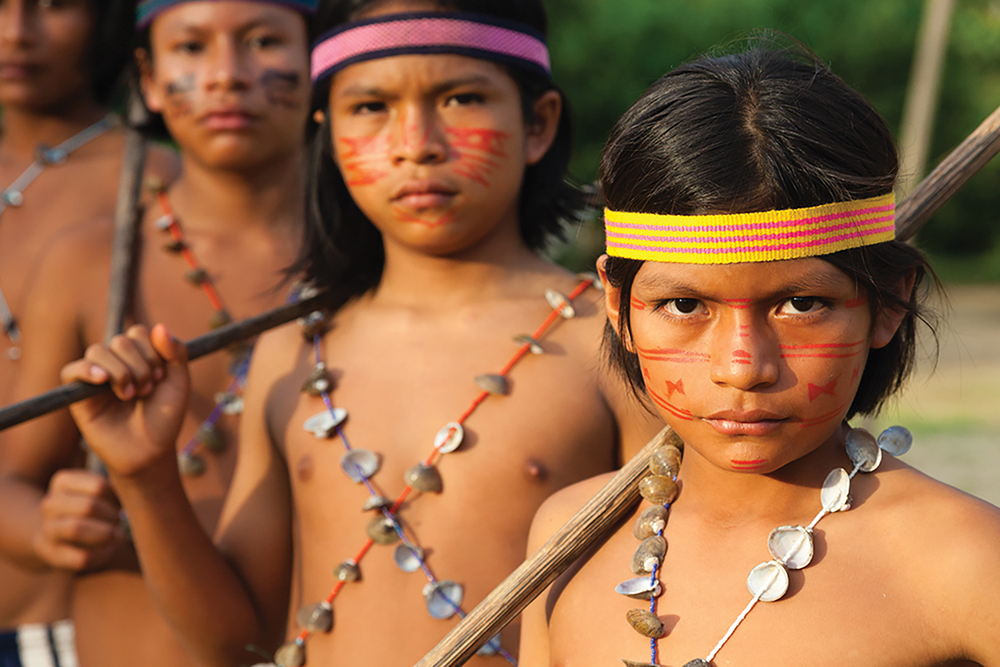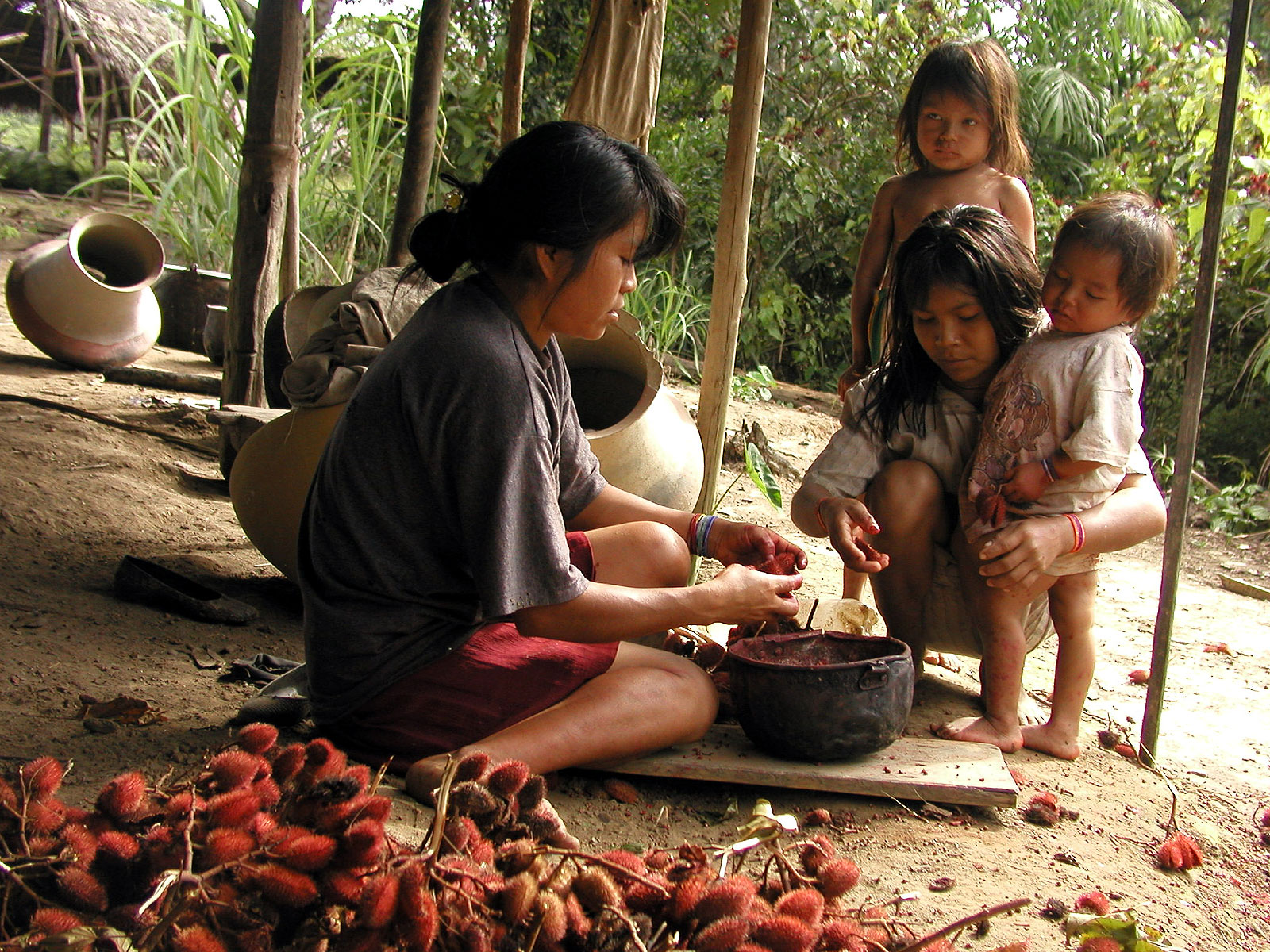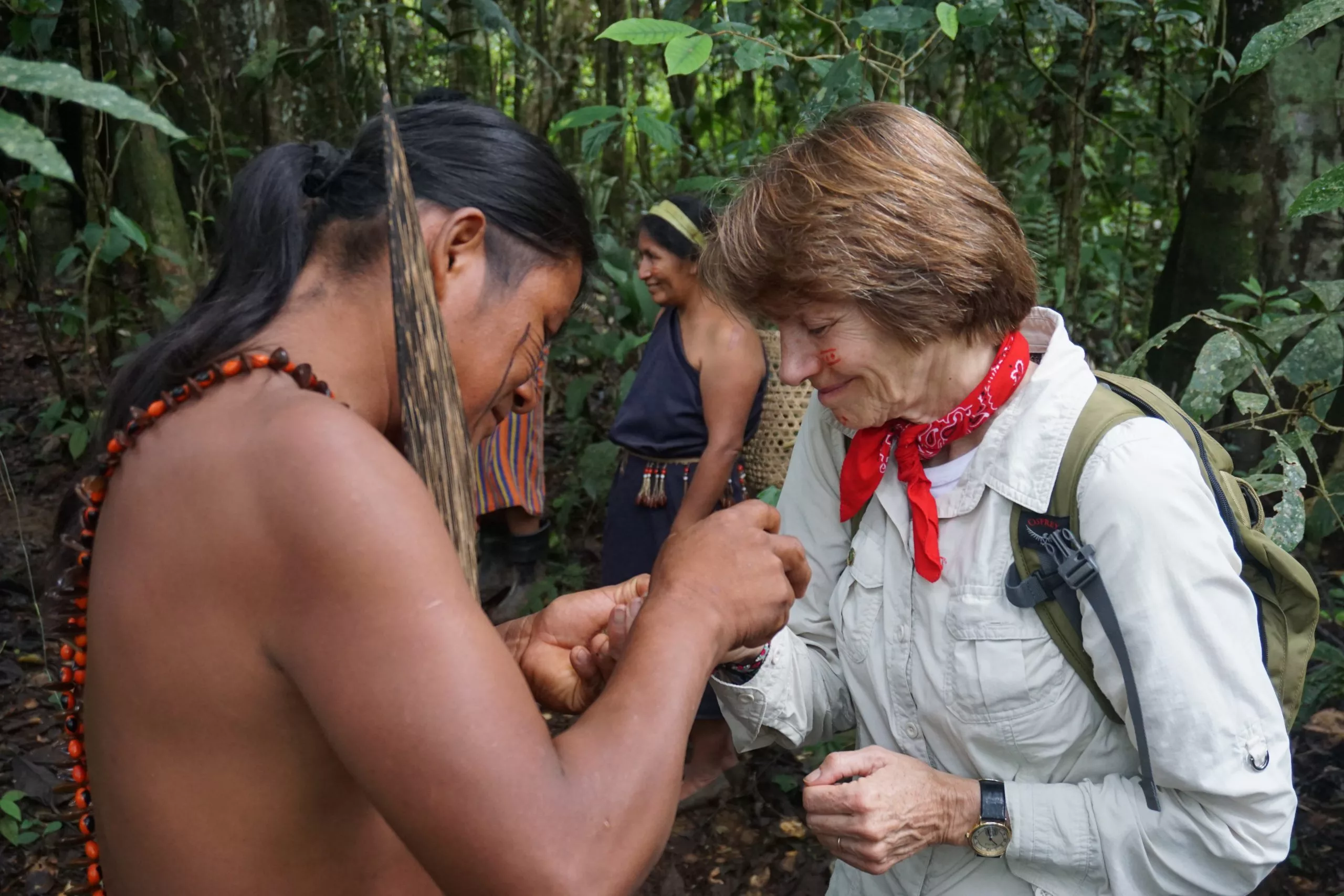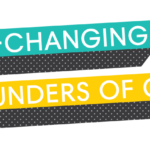We get to meet a lot of amazing, powerful leaders in our work here at Conscious Company — and yet some people stand out even more from that rarified group. Lynne Twist is one of those standouts. She’s a rare combination of driven and playful; flexible, yet clear. She brings a laser-sharp focus to living her values. She’s relentless in her pursuit of changing the dream of modern society, and it’s not all talk — she’s authentic about living it day to day. She sees the core worth of every person she’s with, whether they’re a billionaire or a poor orphan (and she’s spent plenty of time with each). If you’re with her, she’s with you, and she wants to know you.
“I’ve never looked up to any leader as much as I do Lynne,” says Conscious Company co-founder Meghan French Dunbar, who recently spent 10 days traveling with her on a Pachamama Alliance trip to the Amazon rainforest in Ecuador. There was a moment on that journey, after the group had just landed in indigenous territory, when it looked as though they might end up stuck without food or potable water for at least 24 hours. “Lynne’s way of handling it,” says French Dunbar, “was to get people together, be transparent, and tell us what was happening with no fear in her voice. Her energy and careful words turned a situation in which 99.9 percent of people would have freaked out into a fun adventure.” In the end, the trip went smoothly, but that moment encapsulated Twist’s powerful leadership style.
We could tell you more about her background, but we’ll leave that up to her; what follows are condensed remarks from two recorded conversations with Twist, including one on stage at the 2017 Conscious Company Leaders Forum. Enjoy.
Give us a little context about who you are, what you care most about in this life, and how that has shaped your professional journey.
Lynne Twist: I call myself a proactivist. By that I mean an activist for, not against. I’m drawn by a vision.
I like to call myself a person who’s living a committed life, a life where my commitments have shaped me — commitments that I could never accomplish in my lifetime, ways of being and living that move us all forward. When you’re living a committed life, your own small desires start becoming petty. They move to the background and your commitment wakes you up in the morning and tells you what to wear, who to meet with, why to go here or there.
It has given me the most amazing journey. I’ve worked at the feet of Mother Teresa. I was at Nelson Mandela’s inauguration. I was in South Africa the last day of Apartheid. I couldn’t have planned the stuff that’s happened to me. And I’m now working with the Nobel Peace Prize laureates who are women, and I’m the co-founder of the Pachamama Alliance, and I am president of the Soul of Money Institute, and I do all kinds of stuff, like all of you.
Most of all, I’m grateful to have commitments that are bigger than my little life starring me, and that has given me a path that has been a great gift.
Can you tell us more about what those commitments are?
LT: I got involved The Hunger Project. I became completely and totally dedicated — you could say obsessed — with ending world hunger. That was a huge change in my life: from being a mom and a substitute teacher and supporting my husband Bill and having three little kids to being someone who really took on ending world hunger.
That was the first big commitment that shaped and governed my actions, my life, my way of being, and in order to be worthy of that kind of a commitment, I had to become somebody I didn’t know I could ever become.
The more recent commitment is the Pachamama Alliance. We have a beautiful statement, part of our mission, that I consider my commitment now: to bring forth an environmentally sustainable, spiritually fulfilling, and socially just human presence on this planet.
My other central commitment is to constantly do everything I can to facilitate the reallocation of the world’s financial resources away from fear and towards love.
For a chance to meet Lynne Twist in person, join us at our World-Changing Women’s Summit, February 20–22. Click to learn more.
Talk to us about the process of how you came to one of these commitments, and the first steps you took once you realized the commitment you were going to make.
LT: The one that’s easiest to talk about is the Pachamama Alliance. It began 22 years ago. I was deeply engaged in ending world hunger. My energy was focused on sub-Saharan Africa, Bangladesh, Sri Lanka — places like that. I wasn’t thinking about the Amazon rainforest or environmental issues at all.
In 1994, I did a favor for my friend John Perkins and took a little leave from my Hunger Project work in Africa and Asia to go to Guatemala and train the development director for an organization there. We ended up in a shamanic ceremony together, my first ever.
In this ceremony, we were asked to lay down around a fire. The shaman didn’t use any medicine. He told us to close our eyes, listen to his voice, and to journey. I thought that meant take a nice long nap.
But no: the chanting, the drumming, the night air, the crackling fire … I started to feel in an altered state. I started to feel my right arm shake and turn into something that soon became a gigantic wing. Then my left arm. Then I felt this beak-like thing grow on my face, and I absolutely had to fly.
I started to lift myself up with these gigantic wings, and I began to fly into the night sky towards the stars. There was no stopping me from flying. I couldn’t not do it. Then it turned into dawn and I looked down and I was flying in slow motion over a vast unending forest of green. Then these disembodied faces of men with orange geometric face paint and yellow, red, and black feather crowns on their heads started floating up, calling to the bird in a strange tongue, and disappearing back down into the forest. This went on and on and on.
I remember being startled by a loud drumbeat and sitting up and realizing that I was not a bird, I’m a human being, and looking around, and the fire now had gone down to embers. I was completely disoriented. We went around the circle and shared our experiences, and every person — there were 12 of us — had become an animal, except for one woman who fell asleep and dreamed of her grandchildren. It was bizarre and weird and wonderful.
When it was my turn I told the story I’ve just told you, and then it went around to John, and he shared a story almost exactly the same as mine. The shaman then completed the ritual, dismissed everybody else, and sat John and me down. He told us that we were being communicated to, that it wasn’t a normal journey, that someone was reaching out to us and that we needed to go to them.
I had taken leave from ending world hunger. I did not have time for this idea. But John Perkins was totally into it. He said, “Lynne, I know who they are. I know where they are. I was just with the Shuar people in the south-central Amazon of Ecuador. An Achuar warring party came in; they told the Shuar, ‘We’re ready for contact. We’re going to start seeking it.’ These are dream cultures, Lynne, this is how they communicate. It’s the Achuar, I recognize the facial paint, I recognize the headdresses. We have to go.”
And I said, “You are completely nuts. I am not doing that. I have a meeting in Ghana. I’m all about Africa.” So he said, “You’ll see. They will not leave you alone until you go.” I thought, “You know, he’s a nice guy and everything, but he’s a little weird.”
So I went on to Ghana. I’m with my Hunger Project colleagues, sitting around a table, five men and three women. I’m not leading the meeting, thank God. At a certain point, the men, just the men, start having orange geometric face paint appear on their blue-black faces. It just starts to show up. And everyone kept talking as if this was not happening. I thought, “Oh, my God. I’ve gone nuts.”
I excuse myself, go to the ladies’ room, get my act together, and come back. Everybody’s normal. They’re still talking. Then maybe ten minutes later it happens again and I just burst into tears. I thought I had lost it. I told everybody, “I’m feeling very ill. I need to go back to the US. Too many time zones, too much travel, I’m so sorry. I can’t stay, I’m going to go home.”
I got a plane, and the whole way, the faces just kept coming. I was a wreck when I got home. I told my husband, but not the way I’m telling you because I didn’t think it was real. He just said, “You need a break,” which I did, actually.
But it didn’t stop. Then it was constant, happened every day. I was driving through Marin County and I pulled over and just started sobbing. I thought, “I don’t know what to do,” and I tried to reach John Perkins, but he was back in the Amazon. He finally came home to I can’t tell you how many faxes. He called me and said, “They’re waiting for us. It’s the Achuar, we have to go to them.”
They asked John and me through this dream to bring them 12 people including ourselves — people with global voice, with open hearts, people who know the rainforest is critical to the future of life, people who know that indigenous people have wisdom that’s vital for sustainability of the human family, people who would respect the ways of the shaman.
We picked 10 other people including my husband Bill and we went down to Quito and flew in small planes into Achuar territory, landed on a dirt strip near a river. Once we were all there, came out of the forest with their orange geometric face paint; they were all wearing black feather crowns and had spears. That was the beginning of an encounter that changed my life, obviously, and became the Pachamama Alliance.
I’ll say one more thing about it. In that first encounter, they said in their way, “If you’ve come to help us, even though we invited you here, don’t waste your time. But if you know your liberation is bound up with ours, then let’s work together.”

Achuar boys in Ecuador
Photo by Andy Isaacson
Once you felt this call, how did you actually create the Pachamama Alliance? What is it, and what were some of the tangible first steps once you heard the call to commit? What should one do next?
LT: I like the word “call” because this is really a calling, and it was a call from the forest, from the Achuar people. What they wanted to know was how to navigate the outside world. They knew contact was inevitable, so they initiated it on their terms and in their territory.
We agreed to support them for a while. They were forming a political federation so they could relate to what they were learning was the government of the country they were in, which didn’t mean much to them at the beginning; “What’s Ecuador? We live in the rainforest.”
But in order to preserve their land, territory, and culture, not only for themselves but for the future of life, they needed to know they lived in Ecuador. They needed to know about this strange stuff called money, which has the modern world completely by the throat. They didn’t even know there was such a thing — they used to say to us, “You can’t hunt for it, you can’t eat it, why does anybody want it?”
We were basically going to finance their nascent political federation for a year, maybe two. It required, for example, getting a phone line in the town on the edge of the forest, which cost money. We created a little fund called “Friends of the Achuar Nation.” Bill, my husband, said he would open a bank account for them and educate them about simple accounting. He took the money down every three months and had a meeting with them about how to be intelligent with this stuff called money.
The more we worked with the power of the Amazon rainforest — this magnificent, incredible treasure — the more we realized that this call that we thought came from the Achuar actually came through the Achuar from the forest, from the spirit of life. Once we felt that that was what was calling us, I knew this was the next chapter of both of our lives. Bill was a business guy. He had three companies. He was very involved in yacht racing. I was running 50 countries for The Hunger Project. We had kids. We had no time to do this. But once it became clear that it was coming from this spirit of life, we couldn’t not do it.
Extracting myself from The Hunger Project was so hard; it was my life’s work. What saved me is I got malaria. I don’t recommend it, but I was an unstoppable person. I was so committed to the stuff I was doing, I was like a maniac. But I had two strains at the same time and I was really, really sick. I had to stop — like really stop. It was nine months of being sick.
I stopped for long enough that I got it. I saw that this was the future of life we were talking about here. It wasn’t a little tribe in a small region in the Amazon rainforest, it was something much bigger than that, something much more fundamental.
They told us, “The most important work you can do to save the Amazon and to support us is to change the dream of the modern world; the dream of consumption, of acquisition. People can’t change their everyday actions without changing what they’re dreaming for. You actually need to change the dream.”
I got that this wasn’t our plan for ourselves. We knew nothing about the environment. We hadn’t even been thinking about the Amazon. This wasn’t our plan, but it was so clearly our destiny. And we surrendered to it.
It’s now become clear that this region where we were called is the sacred headwaters of the entire Amazonian system. It’s the beating heart of the climate system, and it’s absolutely the most bio-diverse ecosystem on earth. It’s roadless and pristine to this day, and it absolutely must not be touched. Now that we realize we’re not in the middle of nowhere, that we’re at the heart of everywhere, we have totally surrendered to this work and we proliferate the messages that we’ve learned from the indigenous people in 82 countries.
We work in southern Ecuador and northern Peru with the Achuar, the Shuar, the Shiwiar, the Sápara, the Kichwa. We take into the Amazon. We have a program called “Awakening the Dreamer” that we take into businesses to awaken people can be environmentally sustainable, spiritually fulfilling, and socially just. And now we have the Game Changer Intensive
 To pivot a little, let’s talk about how you’ve been able to become such a leader. First of all, what does conscious leadership mean to you?
To pivot a little, let’s talk about how you’ve been able to become such a leader. First of all, what does conscious leadership mean to you?
LT: I think we’re all trying to figure out what that is. It’s a question as well as an answer.
One way I deal with it is: if you’re a leader, you’re leading even when you don’t want to. Much of leadership is the way you live, the way you speak, the way you think, the way you behave, the way you are. To be a conscious leader is to have integrity with all aspects of your life. When you’re having a bad day and you don’t feel like leading, you’re leading others to have a bad day and not feel like leading. You can’t not lead when you’re a leader. You’re modeling all the time.
I don’t consider that I have what you might call a private space to be grumpy or ornery. I don’t think I have that right, and I love that about being a conscious or committed leader. I love that the scope of my leadership encompasses my personal life.
Now some people wouldn’t agree with that. They would say, “You really need your private time.” And I have that too, but even there, I feel I don’t have the right, really, to be small and petty and inappropriate, because that’s inconsistent with what I’m standing for. So the constant challenge of a conscious leader is to be internally and externally consistent with the stand you’ve taken, internally and externally authentic, and constantly expressing yourself in a way that continues to develop not only your leadership skills, but your skills to be an ever more effective human being.
I think a conscious leader is also someone who’s committed to something way larger than their own life, way larger than their own company, committed to some stand or vision greater than they can accomplish in their lifetime so their identity isn’t based in it. Gandhi and Martin Luther King, Jr. and Nelson Mandela and Jane Goodall and the people we truly admire are up to something larger than their own life, and their life is a contribution to that continuum rather than their identity.
That gives you a reason to develop yourself other than just wanting to be better. You’re honing your life because you know it’s a gift you’ve been given so you can give it away.
You say there’s no room for being small or petty. That idea sounds so appealing, yet in practice so far from reality for most of us. How did you get to that point? How do you stay in that integrity all the time in practice?
LT: It’s not that I don’t get petty or grumpy or small. What I said is not that I’m never like that, but that I know I don’t have the right to be that way. I’m not entitled. We all have the opportunity, the privilege, the responsibility to give our best to life. Someone who’s committed to an environmentally sustainable, spiritually fulfilling, socially just human presence on this planet can’t indulge themselves in taking things personally.
When that shows up, it’s much easier for me to let go of that kind of feeling because I’m standing in a place that’s so much bigger than my own personality, identity, wants, or desires. It’s so unproductive. It’s unproductive for anyone, but if you have a big commitment, it’s super unproductive. How are you going to end world hunger or preserve the Amazon rainforest or bring forth a new kind of human presence on this planet when you’re stuck about being angry with your colleague? It’s not that I don’t have those moments. I just get over them pretty fast — faster and faster the older I get.
I work with women who’ve won the Nobel Peace Prize, and you don’t win the Nobel Prize unless you’re extraordinary. One time, I was working with Shirin Ebadi, who won in 2003. She was the number two person in the supreme court in Iran, and she fought for the revolution. She thought the Shah was totally corrupt. And then when the revolution came, they took all women off the supreme court. She was stripped of all her power. She couldn’t even be a judge any longer. She left Iran, her office was burned down. Many women lawyers were killed or sent to jail.
she had been to something like 11 countries in 16 days. I said, “Aren’t you just exhausted?” She scolded me, you might say, for indulging in wanting her to say how exhausted she was, which I was doing. I was trying to get her to say, “Oh, I’m exhausted.” It was like she found that inappropriate. It shocked me, because I was “trying to be supportive.” But what I was doing was I was trying to enroll her in being tired.
She just said, “Don’t indulge me in that conversation. I’m working for the liberation of women in prison, women who are being tortured, women who can’t even leave their homes. I have to keep myself in good enough shape to do my work, but I don’t want anyone feeling sorry for me because I’ve been to too many countries in too short a time. I’m fine and I’m going to be resting this afternoon.” Something about that conversation shifted my whole sense of myself.
I’m noticing a fear come up in myself around that idea — a fear of burnout or a fear that that attitude could, misused, perhaps lead to joylessness.
LT: Burnout, in my view, is being disconnected from Source. I don’t think it’s as related as we think to working too long or too hard or eating pizza and Coke instead of veggies and water. All those things play into it — I don’t recommend working yourself to death or anything. But true burnout is being disconnected from Source. That’s really where it happens. We all know times when we were soaring: we were working 24/7 and we wanted to work 24/7, and what we were producing was so exciting that we couldn’t stop. That’s one example of being connected to Source in a way that your body will go with you.
At the same time, I do think it’s important to take care of one’s capacity to serve. That’s the other thing I feel responsible to take care of: to nourish my own capacity to serve, and that comes from Source. That comes from meditation. That comes from being in nature. That comes from being in touch with the love I have for my husband and my children and my family. My love for God. My love for the spirit world. My love for the shamans. When I’m in touch with that, I can do anything. And then that’s a source of enormous joy.
We once had a conference in Ireland with the Nobel laureates. We sponsored women to come from war zones all over the world. This conference was very confronting.
At one point on the second day, I was having lunch with colleagues from Iran, four lawyers who worked with Shirin Ebadi. A group of six women arrived in a van. My colleagues saw the van pulling up and they ran across this green lawn crying with joy. They were all lawyers who had worked together for years before they got arrested. As the women got out of the van, women who had been in prison for years and tortured, they all ran towards each other and they hugged and they rolled around on the grass and they cried and they danced. It’s making me cry thinking about it.
Then that night we had a party, the most joyous, raucous, wild, wonderful party of all women dancing with each other that I’d ever seen in my life; women from the Congo, women from Ethiopia, women from Honduras, all of whom had been through hell — the kind of things they’ve been through, you can’t even talk about.
My assertion from that enormous experience, and I’ve had many experiences like that, is that the pain and the joy are one. It’s all connected. And often the deeper people have allowed themselves to go into the pain, the greater capacity they have for joy.
I’ve seen that particularly with African women, with their incredible burdens in many cases. But when they celebrate — which they find a way to do every day, through singing, through dancing, through feeding each other — the joy is just breathtaking. I’ve been in Rwanda after the genocide and found the joy there in those people. I’ve been in Ethiopia after the famine. The capacity for human joy is probably unlimited.
I find it in myself. I find that my capacity for joy is enhanced by my capacity to face the suffering world and engage with it. My capacity for joy and lightheartedness and fun and release is strengthened by my capacity to face the darkness. And my capacity to face the darkness is strengthened by my capacity to celebrate joy. The harder I work, the more I love.
Also as a leader, it’s my job to create possibility in every situation. Not just positive thinking, not a Pollyanna hug, smoothing over things that aren’t working. Generate possibility. See possibility. Find the goal. Find the teaching. Find the love. Find the joy in everything.






